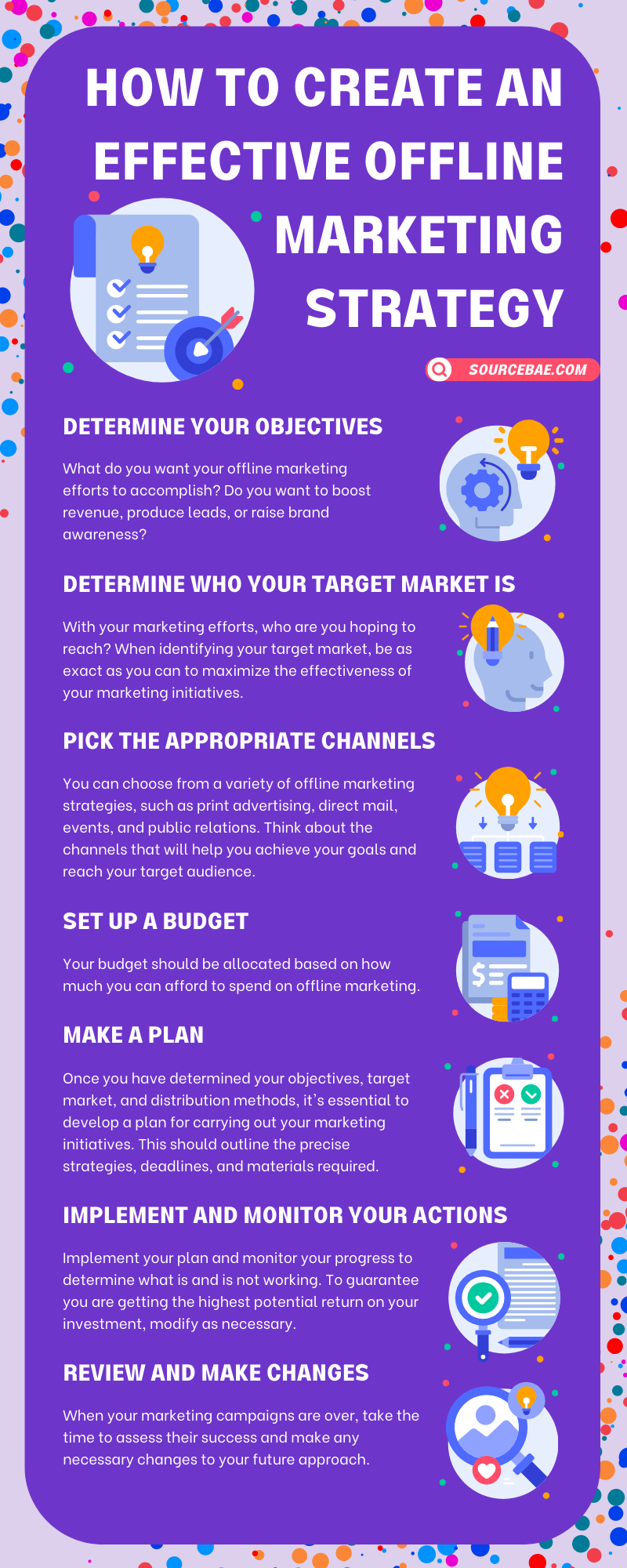In today’s digital age, where online marketing often takes the spotlight, it’s important not to underestimate the power of offline marketing strategies.
When implemented effectively, offline marketing can establish a deeper connection with your target audience, enhance brand recognition, and drive tangible business outcomes.
In this article, we’ll delve into the art of creating an effective offline marketing strategy that resonates with your audience and delivers exceptional results.
How to Create an Effective Offline Marketing Strategy

Offline marketing strategies are a crucial component of any well-rounded marketing plan. They involve reaching potential customers through channels that don’t rely on the internet. These strategies can include events, print materials, direct mail, radio, television, and more. To ensure your offline marketing strategy is a success, consider the following steps:
Identifying Your Target Audience
Before you embark on any marketing endeavor, understanding your target audience is essential. Identify their demographics, preferences, pain points, and behaviors. This information will help tailor your offline marketing efforts to resonate effectively.
Setting Clear Goals and Objectives
Every successful marketing strategy begins with clear and achievable goals. Determine what you aim to achieve with your offline efforts – whether it’s increased brand awareness, lead generation, or sales growth. This will guide your decision-making throughout the strategy development process.
Crafting a Compelling Message
Your message should be succinct, engaging, and aligned with your brand’s voice and values. Highlight the unique value proposition your product or service offers, addressing how it can solve your audience’s challenges or fulfill their desires.
Choosing the Right Offline Channels
There are numerous offline marketing channels to choose from, and selecting the ones that best align with your goals and target audience is crucial. These may include trade shows, seminars, workshops, billboard advertising, and more.
Integration with Online Efforts
Offline and online marketing strategies should complement each other. Create a seamless experience for your audience by integrating your offline efforts with your online presence. For instance, use QR codes on printed materials that lead to specific landing pages on your website.
Measuring and Analyzing Results
Implementing an effective offline marketing strategy requires continuous measurement and analysis. Use tracking mechanisms to monitor the performance of your campaigns, such as tracking codes on direct mail pieces or unique promo codes for events.
Leveraging the Power of Face-to-Face Interactions
In an era dominated by digital interactions, face-to-face interactions hold a special place in the hearts of consumers. The authenticity and personal touch of in-person encounters can leave a lasting impression. Here’s how to make the most of them:
- Hosting Memorable Events: Organize workshops, seminars, or product launch parties to bring your brand to life. These events offer a chance for meaningful interactions and hands-on experiences with your offerings.
- Networking Opportunities: Attend industry-specific conferences and trade shows to connect with potential customers, partners, and collaborators. These events offer a platform for relationship-building that online platforms can’t replicate.
- Creating Lasting Memories: Distribute branded promotional items, such as pens, mugs, or tote bags, during events. These items serve as tangible reminders of your brand and can spark conversations even after the event ends.
Mastering the Art of Print Marketing
Print marketing might seem old-fashioned, but it remains a powerful tool for conveying your message effectively. To utilize print materials as part of your offline marketing strategy, consider the following:
- Design Aesthetics: Invest in high-quality design that aligns with your brand’s identity. Whether it’s business cards, brochures, or flyers, visually appealing materials can capture attention and leave a positive impression.
- Compelling Copywriting: Craft persuasive and concise copy that communicates the essence of your brand and offerings. Address your audience’s pain points and showcase how your solutions can make a difference.
- Direct Mail Campaigns: Direct mail can be surprisingly effective when done right. Segment your mailing list, personalize your messages, and include compelling offers to encourage engagement.
FAQs About Creating an Effective Offline Marketing Strategy
Q: How do I determine which offline channels are best for my business?
A: Conduct market research to understand where your target audience spends their time offline. Choose channels that align with your audience’s preferences and behaviors.
Q: Can I track the success of offline marketing campaigns?
A: Yes, there are various ways to track offline campaigns. Use unique promo codes, custom landing pages, or QR codes to measure the impact of your efforts.
Q: Is face-to-face interaction still relevant in today’s digital world?
A: Absolutely! Face-to-face interactions offer a level of personalization and authenticity that can’t be replicated online. They can foster stronger connections with your audience.
Q: What’s the key to a successful print marketing campaign?
A: The key lies in a combination of compelling design and persuasive copy. Your materials should be visually appealing and effectively convey your brand’s value proposition.
Q: How do I ensure consistency between offline and online marketing efforts?
A: Maintain consistent branding, messaging, and design elements across all channels. Use similar color schemes, fonts, and tone of voice to create a cohesive brand identity.
Q: Is it worth investing in offline marketing when digital marketing is dominant?
A: Absolutely. Offline marketing can provide a competitive edge by tapping into audience segments that might not be as reachable through digital channels. It complements your overall marketing strategy.
Conclusion
Crafting an effective offline marketing strategy requires a deep understanding of your target audience, clear goals, and a strategic approach to channel selection. By combining the power of face-to-face interactions and print materials, you can create memorable experiences that resonate with your audience. Remember, offline marketing isn’t a thing of the past – it’s a valuable tool that, when used strategically, can drive remarkable results.





